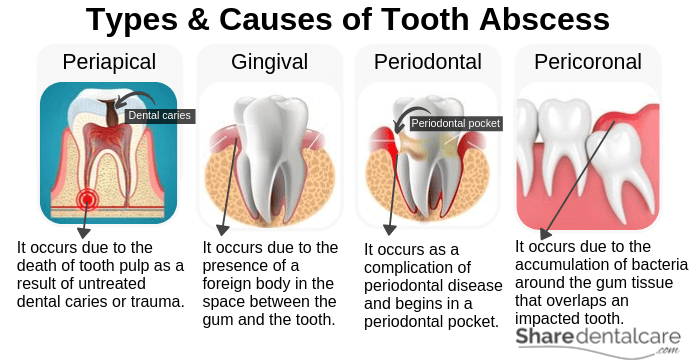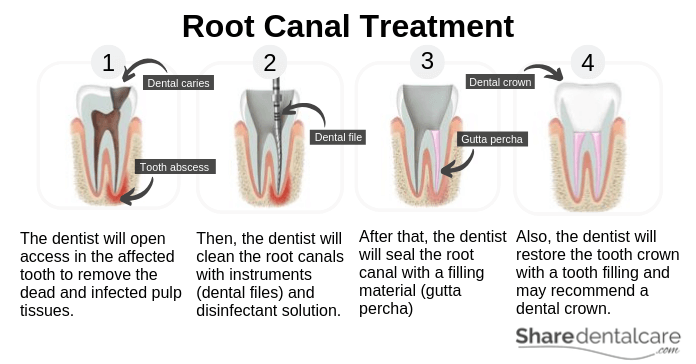A tooth abscess is a collection of pus that can form in different parts of the oral cavity as a result of bacterial infection. It can cause pain that increases in severity with pressure or heat. Also, dental abscesses may cause gum swelling, pus discharge, facial swelling, and tenderness of the lymph nodes. Visit your dentist as soon as possible if you have these signs and symptoms to get immediate tooth abscess treatment and relieve the pain.
What Causes Dental Abscess?
Tooth abscess treatment depends on the type of abscess. Each type occurs in a different place for a different reason and may require a different treatment. Types of dental abscess include:
- Periapical abscess
- Gingival abscess
- Periodontal abscess
- Pericoronal abscess
A periapical abscess occurs due to the inflammation or death of tooth pulp as a result of untreated tooth decay or trauma. The dental pulp is the soft tissue inside the tooth that contains nerves, blood vessels, and connective tissue. The periapical abscess forms around the root tip.
A gingival abscess occurs due to the presence of a foreign body in the space between the gum and the tooth. Gingival abscess doesn’t affect the tooth-supporting tissues (the periodontal ligament).
A periodontal abscess occurs as a complication of gum disease and begins in a periodontal pocket. Poor oral hygiene can lead to the inflammation of gum tissues and the formation of periodontal pockets (deep space around teeth). When these pockets become infected, this will lead to severe pain, the destruction of periodontal ligaments, and the formation of a periodontal abscess alongside the tooth.
A pericoronal abscess occurs due to the accumulation of bacteria and food debris around the gum tissue that overlaps an unerupted tooth. Pericoronal abscess is usually associated with partially erupted or impacted lower wisdom teeth (wisdom Tooth Abscess).

Symptoms of Abscessed Tooth
A tooth abscess is usually painful. The pain occurs suddenly and gets worse over time. Other signs and symptoms of dental abscess include:
- Severe pain that can radiate to the jaw, neck, and ear.
- Tooth sensitivity to hot or cold foods and drinks.
- Pain when biting or chewing.
- Tender swelling and redness of the gum.
- Formation of pocket of pus in the gums.
- Bad taste in the mouth.
- Loose teeth.
- Tooth discoloration.
- Bad breath.
- Obvious swelling of the face.
Tooth Abscess Home Treatment
You can’t treat dental abscesses at home. However, you can try these home remedies to relieve the pain until you can see your dentist:
- Use an over-the-counter medicine for pain relief, for example, ibuprofen, paracetamol, or aspirin. Consult your doctor or pharmacist before taking OTC medications.
- Avoid hot or cold foods and drinks.
- Don’t chew on the affected side of your mouth.
- Eat soft, cool foods on the opposite side of your mouth.
- Don’t eat hard food.
- Use a soft-bristled toothbrush and don’t floss around the abscessed tooth.
- Sleep with your head elevated. Because the blood rushes to your head when you sleep, making the pain worse.
These home remedies can provide temporary relief for the symptoms of a tooth abscess, but they are not a substitute for proper dental treatment. It is important to seek professional dental care as soon as possible to address the underlying cause of the abscess and prevent further complications.
Can a Tooth Abscess Go Away on Its Own?
No, a tooth abscess cannot go away on its own. The infection will continue to worsen and can spread to other areas of the mouth, head, and neck. Seeking prompt dental treatment is crucial to prevent the tooth infection from becoming more severe and causing potential complications.
When To See a Dentist?
It is crucial to see a dentist as soon as possible if you have severe pain or gum swelling to get professional dental care and tooth abscess treatment. Tooth abscess won’t go away without professional treatment.
An untreated abscess may spread to other areas, causing a life-threatening infection, such as Ludwig’s angina and sepsis. Go to the emergency (ER) if you have the following symptoms to get immediate medical attention:
- High fever and fatigue.
- Severe facial swelling.
- Swollen lymph nodes.
- Limited mouth opening.
- Difficulty swallowing and breathing.
So, you should visit your dentist as soon as possible for professional dental care and to get tooth abscess treatment before the infection spreads to other areas.
Tooth Abscess Treatment Options
The tooth abscess treatment depends on the underlying cause. So, your dentist will examine your oral cavity and use X-rays to determine the cause of the abscess. Then, your dentist will start the dental treatment. The goal of the tooth abscess treatment is to eliminate the infection and relieve the pain.
Drainage of the Abscess
In the case of a large abscess, your dentist will make a small cut in the gum to drain the pus. Then, your dentist will clean the area with saline. Drainage of the abscess can provide temporary relief for the tooth pain and prevent the spread of infection to other areas. After that, you will need further dental treatment.
Antibiotics
Your dentist will prescribe antibiotics if the dental abscess is severe or has spread to other parts of the body to help clear the infection. Also, the dentist will prescribe antibiotics for patients with a weakened immune system. Antibiotics don’t substitute tooth abscess treatment and further treatment will be needed.
Root Canal Treatment for Tooth Abscess
A root canal treatment involves the removal of inflamed and infected pulpal tissues from the pulp cavity and pulp canals. The tooth pulp becomes infected and inflamed due to:
- Deep tooth decay.
- Crack or chip in the tooth.
- Trauma.
- Large tooth fillings.
If the pulpal tissues become inflamed and infected, this will lead to the formation of a dental abscess around the root tip (periapical abscess). You may notice a tender swelling around the affected tooth.
To treat the abscessed tooth, your dentist will perform a root canal treatment (RCT). First, your dentist will open access to the affected tooth to remove the dead and infected pulp tissues. They will clean the pulp cavity. Then, they will clean root canals with instruments (dental files) and disinfectant solution to eliminate the infection.
Finally, your dentist will seal the root canal with a filling material (gutta percha) to prevent the recurrence of infection.
Also, your dentist will restore the tooth crown with a tooth filling, such as composite or amalgam. Root canal treatment may require multiple visits to the dental office and its performed under local anesthesia. After RCT, your dentist will recommend a dental crown to protect the tooth and restore its function.

Scaling and Root Planing
Scaling and root planing is a procedure that involves the removal of plaque and calculus to help treat periodontal disease (advanced gum disease). Poor oral hygiene leads to plaque build-up, causing the inflammation of gum tissues (gingivitis).
If the inflamed gum is left untreated, bacteria in plaque will produce toxins and poisons that break down the bone and connective tissue that hold teeth in place (periodontitis). This will lead to the formation of periodontal pockets which are small spaces between teeth and gums. These pockets collect food debris and can become infected, causing pain and the formation of a periodontal abscess. Several factors increase the risk of periodontal disease, including:
- Smoking.
- Poor nutrition.
- Poor oral hygiene.
- Changes in hormones.
- Medical conditions.
In this case, your dentist may recommend scaling and root planing for tooth abscess treatment. First, your dentist will remove plaque and calculus from your teeth and periodontal pockets (scaling). Then, your dentist will smooth the tooth roots (root planing) to help your gums to reattach to your teeth. Scaling and root planing may require multiple visits to the dental office. The tools used to perform the procedure include:
- Hand instruments (periodontal sealers and curettes).
- Ultrasonic devices.
- Laser devices.
After the procedure, your dentist may prescribe an antibiotic and a mouthwash to speed the healing process.
Tooth Extraction
Your dentist may recommend a more invasive procedure to help eliminate the infection. Tooth extraction is recommended in the following cases:
- The infected tooth is severely damaged and can’t be restored.
- Severe infection that antibiotics and root canal treatment don’t cure it.
- The tooth is loose due to the destruction of the tooth-supporting tissues (periodontal ligament) as a result of gum disease.
- Impacted or unerupted tooth wisdom teeth.
Tooth extraction is usually performed under local anesthesia by a dentist or oral surgeon. Tooth extraction can be simple or surgical. In the simple extraction, your dentist uses instruments (elevator and forceps) to loosen and remove the tooth.
If the tooth is severely damaged, your dentist may perform a surgical extraction. your dentist will make a small incision into your gums and cut your tooth into pieces to facilitate its removal.

Can an Abscessed Tooth Be Prevented?
Preventing a tooth abscess involves maintaining good oral hygiene practices and seeking prompt dental treatment for any signs of infection or dental issues. Here are some tips to help prevent tooth abscess:
- Brush and floss regularly: Brush your teeth at least twice a day and floss once daily to remove plaque and food particles that can contribute to tooth decay and gum disease. Use a fluoride toothpaste to strengthen tooth enamel and combat bacteria.
- Visit your dentist regularly: Regular dental check-ups and cleanings are essential for detecting early signs of tooth decay or gum disease before they progress into a tooth abscess. During regular checkups, your dentist can identify any issues and provide necessary treatment to prevent complications.
- Practice good dental habits: Avoid habits like smoking and excessive alcohol consumption, as they can weaken the immune system and increase the risk of dental problems. Additionally, avoid using your teeth as tools to open things, as this can lead to tooth damage and potential infections.
- Treat dental issues promptly: If you experience dental pain or sensitivity, or notice any signs of abscess, such as swelling or pus discharge around a tooth, seek dental treatment as soon as possible.
- Maintain a healthy diet: Eating a balanced diet that is rich in vitamins and minerals helps to support a strong immune system and promote overall dental health. Avoid excessive consumption of acidic and sugary foods and drinks, as they can contribute to tooth decay and increase the risk of developing an abscess.
Tooth Abscess Treatment – Conclusion
In conclusion, tooth abscess treatment is crucial in order to alleviate pain and treat the underlying infection. It is important to seek immediate dental care if you suspect you have a tooth abscess, as early treatment can prevent further complications.
Your dentist will determine the tooth abscess treatment option based on the underlying cause, the severity of the infection, and the tooth condition. The dental treatment may include draining the abscess, performing a root canal, or scaling and root planning. In severe infection, the dentist may recommend a more invasive procedure – tooth extraction.
Take an over-the-counter medicine for pain relief, such as ibuprofen or paracetamol. Antibiotics are often prescribed to clear the infection and prevent it from spreading.
While tooth abscesses can be quite painful and uncomfortable, the good news is that with proper care and treatment, they can be effectively managed.
Remember, prevention is always better than cure. By maintaining good oral hygiene, practicing healthy dental habits, seeking prompt dental treatment, and regular dental checkups, you can reduce the risk of developing a dental abscess and ensure the health of your teeth and gums.